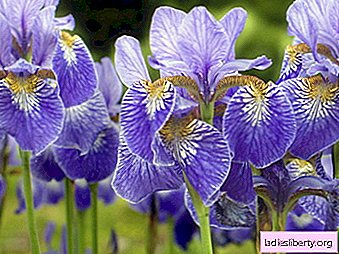
Kind Iris (Iris) from the Irisaceae family (Iridaceae) is very diverse and is represented by approximately 800 species of beautiful plants. Its very name speaks of a resemblance to a rainbow (that is how it is translated from Greek). In Russia, the iris flower is often called a killer whale. It is a perennial wintering plant that has creeping thick branching rhizomes or bulbous roots. It has dense, erect leaves and large flowers that attract attention with its bizarre shape and bright color.
Today, iris is spread all over the world, but the largest number of its species will grow in the countries of the Mediterranean, Southwest and Central Asia. The name of this flower is even assigned to one of the nebulae in the constellation Cepheus, which in its appearance resembles an iris. Without these plants today it is impossible to imagine any garden; their magnificent flowering impresses with a variety of colors and delights with its subtle and refined beauty.
Irises - growing and care
Caring for irises is not at all complicated and consists of the usual for every gardener procedures for weeding, loosening the soil, removing weeds, fertilizing and watering.
Irises are winter hardy, so they winter in the open ground. Also, these flowers are unpretentious to the soil, but they grow best on loamy soils with a neutral reaction. In one place they can be grown for about 7 years.
For irises, good lighting is very important. If they are planted in the shade, they will bloom very poorly and lose all their beauty. Therefore, when choosing a place for planting, one should not forget about the photophilousness of these plants. It is very good if it is a place protected from strong winds, with soil that will not be excessively moistened by ground water located close to the surface, so that the rhizomes do not begin to rot and die. Waterlogging of the soil can also cause brown spots on the leaves of irises and their decay. Therefore, starting in the second half of summer, watering should be reduced.
Very gratefully they respond to fertilizer application. The time of the first feeding is early spring. The soil in which the irises are planted is sprinkled with readily soluble full mineral fertilizer. Dry fertilizer is taken at the rate of about 10 grams per 1 flower. The second top dressing in time coincides with the period of budding - the beginning of flowering of irises. It is produced with the same fertilizer taken in the same amount as with the first feeding. For the third time, irises are fed in August, when the flowers begin the second phase of vegetation. This top dressing is necessary to increase the immunity of the plant and its resistance to winter cold. In this case, it is necessary to use not nitrogen, but phosphorus or potassium fertilizer.
Irises - transplant and reproduction
In order to prevent the rhizome from crowding out onto the soil surface, which will lead to a reduction in the frequency of flowering of irises, it is recommended that they be divided and transplanted every 3 to 5 years. It is best to transplant irises immediately after the end of their flowering or growing season, so that the plant has time to take root, otherwise, with a later transplant, it may die.
If irises are replanted at the end of summer, then by the next spring some of them will already bloom. The most intense flowering is observed 2-3 years after planting. Before planting irises, the soil should be well dug up and tilled, it also needs to be fed with mineral fertilizer. Experienced gardeners do not recommend introducing manure into the soil for irises.
They are propagated by seed and vegetative means. The seed method, as a rule, is used for hybridization, in this case, flowering occurs only after 2-3 years. Therefore, amateur gardeners apply a simpler method of plant propagation - vegetative. Having planted irises in a vegetative way, it will be possible the next year after planting to admire the chic flowering specimens. It is possible to propagate in this way both varietal and wild-growing irises.
To divide the plant, you need to select a well-developed bush and, shaking it off the ground, break its rhizome so that on each part of it there is a leaf bunch and a piece of rhizome. Then you should prune the leaves (about half) and the roots (one third), remove dry and diseased leaves. The rhizome should also be cleaned of rotten parts. Having prepared the planting material in this way, it should be disinfected by dropping it in a weak solution of manganese for 15 to 20 minutes and then drying it in the sun. Experienced gardeners recommend sprinkling a slice with a compound prepared from sulfur taken in equal parts with crushed coal. Before planting, a hole is dug out in the ground, while a small mound should remain in its center, on which you need to put the rhizome and carefully spread the roots on the sides. Each plant should be separated from the other by about half a meter.
Irises - Diseases and Pests
Irises are resistant to diseases and pests, however, like other plants, various diseases can affect them. The most dangerous of them is rot of rhizomes and base of leaves. As a rule, it occurs due to waterlogged soil at the place of iris growth. In this case, you should dig up the plant and, having cut out all the affected rhizomes, place the healthy root for about half an hour in a solution prepared from the “Khom” preparation at the concentration indicated in the instructions. If the weather is sunny, then after processing the rhizomes should be held in an open place for about 12 hours, from time to time they are turned over.
Also, irises can be affected by heterosporosis. This usually occurs in the second half of summer. The disease can be recognized by small brown spots on the leaves of the plant. In order to save the iris in this case, you need to cut off all the affected leaves and burn them, and then treat the plant with copper sulfate (50 g of the drug is taken for 5 liters of water).
To ensure the health and abundant flowering of irises, you should also deal with their pests in time. The most dangerous of these is gladiolus thrips. You can find out its presence by the leaves of the plant, which look oppressed, lose their wax coating. To get rid of this pest, you need to treat the iris with Confidor. The solution is prepared from 10 liters of water and 1 ml of the drug; per 10 square meters m. planting irises, the flow rate of the solution should be about 1 liter.
Comments
Here I pick up //greensad.com.ua/ua/category/irisy/
What do you say about Hustle?











